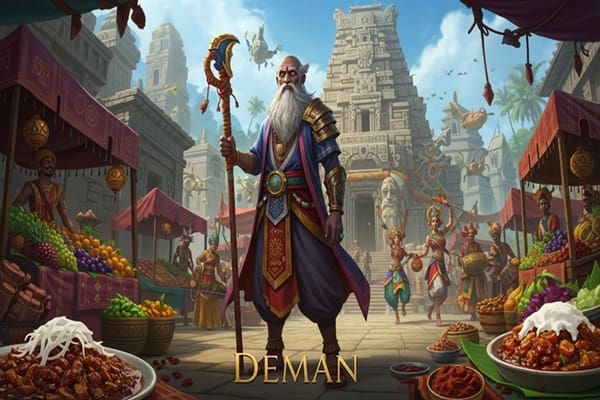Đeman: A Multifaceted Symbol of Culture, Myth, and Culinary Delight

Why You Should Care About Đeman
Ever stumble on a word that means totally different things depending on where you’re from? Meet đeman—a term that’s popped up in mythology, performing arts, and cooking across the globe. From Eastern European forest spirits to Vietnamese folk performances and Indonesian spice racks, đeman weaves its way through traditions in ways that might just surprise you. So, let me walk you through the journey of đeman—its origins, its evolution, and why it still matters today.
1. Đeman in Eastern European Folklore: Guardian of the Forest
In Slavic and Eastern European legends, đeman shows up as more than just a forest spirit. It’s a guardian of nature, balancing good and bad depending on how people treat the woods.
-
Protector with a Purpose: Đemans are friendly if you respect the forest—for example, don’t chop down a sacred tree—but you’ll regret it if you don’t.
-
Folklore With a Lesson: One story tells of a farmer who destroys part of the forest, only to be humbled and guided to replant trees. Đeman reinforces the idea of human responsibility toward nature.
-
Moral Compass: Reminds people that nature isn’t here to be dominated—it’s here to be honored.
Spiritual figures like đeman offered society a sense of accountability long before environmental ethics became mainstream.
2. Đeman as Vietnamese Performing Art: Song, Dance, and Poetry
Thousands of miles away, đeman becomes something entirely different in Vietnam—a rich cultural performance blending music, dance, and poetry.
-
What to Expect: A poetic dance using traditional instruments like the đàn tranh (plucked zither) and wooden flute—think of it as a live narrative told through rhythm, movement, and words.
-
Cultural Conversation: The performances often explore themes like love, social change, or the struggles of everyday people.
-
Community Connection: Audiences experience shared emotion through stories expressed in multiple artistic layers.
Vietnamese đeman is less folklore, more a living art form that honors tradition while engaging with modern life.
3. Đeman in Southeast Asian Cuisine: Spice With a Story
On the flip side, in culinary circles—especially in Indonesia—đeman refers to a fragrant spice, often linked to the Indonesian bay leaf.
-
Flavor Profile: A heady blend of citrus, eucalyptus, and clove—perfect for enhancing curries, soups, and stews.
-
Health Ally: Often credited with aiding digestion and offering antioxidants.
-
Warm Welcome: Used ceremonially to symbolize hospitality and prosperity in traditional Southeast Asian dishes.
In kitchens across Bali and Java, đeman isn’t just seasoning—it’s cultural seasoning.
4. Symbolism & Modern Meaning of Đeman
What connects these very different interpretations of đeman?
-
Cultural Keepsake: Whether spirit, performance, or spice, đeman carries historical and symbolic weight in each context.
-
Adaptability: Its transformation across cultures shows how concepts evolve while remaining rooted.
-
Living Legacy: All forms still act as cultural connectors—reminding us who we are, which stories matter, and where we came from.
5. From Mythical Forests to Global Tables
Tracing đeman’s path reveals bigger patterns in culture and globalization:
-
Folklore Roots: Values of respect—for nature and tradition—are embedded in mythic đeman.
-
Artistic Expression: Vietnamese đeman proves tradition can be alive and evolving.
-
Culinary Culture: The spice version reveals how ingredient traditions shape our sense of place.
We see how traditions evolve, spread, and adapt, carrying meaning in new forms.
Also Read : The Rising Popularity of the Swimsuit Edition [ABBB] – 1.20 21 Swimsuit Edition – Chapter
6. What We Can Learn From Đeman Today
Here’s what embracing đeman teaches us:
| Lesson | What It Means for You |
|---|---|
| Respect Tradition | Folklore reminds us to honor past wisdom |
| Embrace Expression | Art evolves—so should we |
| Support Culture | Even cooking is a form of expression and pride |
By learning about đeman, we lean into our shared stories—from forest spirits to lively performances and tasty dishes.
7. Your Đeman Adventure: Getting Started
Curious? Here’s how to dive deeper into đeman’s many forms:
-
Read a folktale: Look up Eastern European myths about forest spirits or guardian entities.
-
Experience local art: Seek out Vietnamese folk music or cultural events in your community.
-
Taste it: Find Indonesian bay leaf—try it in a curry or soup.
-
Reflect on it: What do you appreciate more—myth, melody, or flavor?
Wrapping Up: Why Đeman Still Speaks to Us
From mysterious forests to classroom performances and dinner plates, đeman shows us how a single word—or idea—can transcend boundaries. It reminds us that culture isn’t static. Art, legend, flavor—they all evolve and spread, carrying pieces of who we are.
So next time you hear “đeman,” you’re not just hearing a word. You’re encountering a story—a crossroads of human values. And that’s pretty special in today’s interconnected world.



